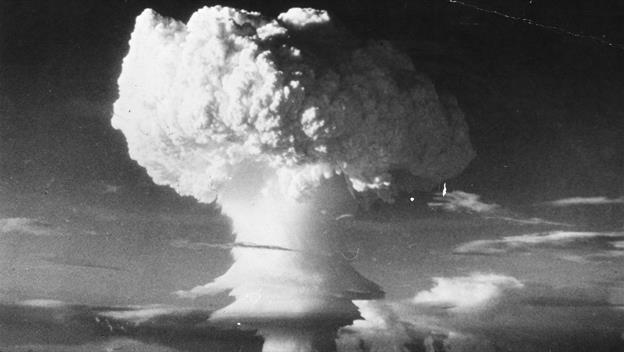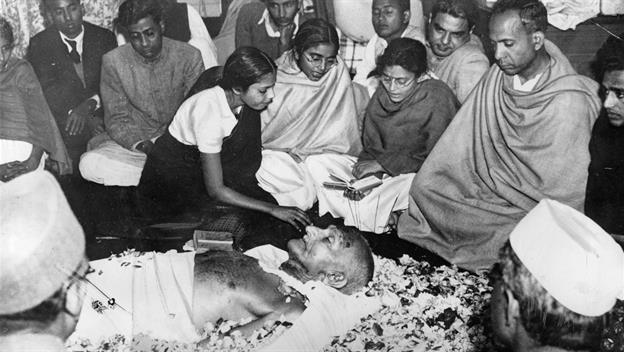War History Online has an article (using a list by listverse.com) about some particularly ugly World War Two history:
On the eve of VJ Day, and with Japan’s Prime Minister Shinzo Abe expressing ‘profound grief’ for World War Two, here are ten Japanese atrocities:
Laha Airfield Massacre
February of 1942
This ghoulish event, which killed more than three hundred Australian and Dutch POWs, followed the Japanese capture of the Indonesian island of Ambon. Allegedly as an act of reprisal, after the Allies destroyed one of their minesweepers, the Japanese randomly selected prisoners and executed them via beheading and bayonet near the island’s airfield. They then repeated the process three more times during the month.
The magnitude of this atrocity was enough for an Australian military tribunal to prosecute more than ninety Japanese officers and soldiers after the war in one of the biggest war crime trials in history. The tribunal sentenced four of the accused to death and handed out a range of sentences for the others. Unfortunately, they never got to try the mastermind, Rear Admiral Hatakeyama. who died while awaiting his trial.
Alexandra Hospital Massacre14 & 15 February 1942
Just a day before the British surrendered Singapore, Japanese soldiers stormed the Alexandra Military Hospital and slaughtered its occupants, including the medical staff and patients. Even those undergoing surgery were not spared.
Following the massacre, the Japanese forced those left to clean up the mess and then herded them into cramped rooms. When morning came, the Japanese rounded up the two hundred survivors (some had died during the night) and bayoneted them in the courtyard. Only five survived the second massacre by hiding in a storm drain.
General Yamashita, upon learning of the incident, had the offending soldiers apprehended and executed.
Palawan Massacre14 December 1944
In another case of POW massacre, the Japanese stationed on Palawan Island in the Philippines tried to kill all their American prisoners after wrongly assuming Allied forces had invaded. After driving the prisoners into makeshift air raid shelters, the Japanese burned them alive.
Those who fled the burning structures were bayoneted, shot, or bludgeoned to death. A few dozen managed to make it as far as the shoreline and hide there; the Japanese caught, tortured, and executed almost all of them. Of the hundred and fifty prisoners, less than a dozen survived to tell the tale, somehow finding the strength to swim across a bay to safety. News of this grisly massacre prompted Allied forces to embark on a series of raids to liberate prisons and camps held by the Japanese across the archipelago.
Japanese occupation of NauruAugust of 1942 through September of 1945
Even the small South Pacific island of Nauru did not escape the horrors of the war. During their occupation of the island, the Japanese committed a string of atrocities, and a few stood out for their brutality.
After a raid on the island’s airfield by American bombers on March 1943, the Japanese beheaded and bayoneted five interned Australians in retaliation. That same year, the Japanese also forcibly deported more than a thousand indigenous inhabitants as labor to other occupied islands to conserve rations.
During their occupation, the Japanese singlehandedly exterminated the island’s leper colony. Stowing the island’s forty lepers on a boat, the Japanese led them far out to sea and out of sight. Afterward, Japanese gun boats fired at the vessel, sinking it and killing all onboard.
Akikaze executions18 March 1943
In what could be argued as an uncharacteristic yet brutal incident, Japanese forces executed a boat of German civilians suspected of spying for the Allies.
The incident began after the Japanese destroyer Akikaze, en route to the Japanese stronghold in Rabaul, picked up German missionaries and Chinese civilians living in the South Pacific islands of Kairuru and Manu. En route to their destination, the captain of the ship received instructions to execute the entire group. To accomplish this quietly, the Japanese led their victims one-by-one to the back of the ship to a makeshift gallows.
After securing the victims’ wrists to a pulley, the Japanese shot and whipped the bodies, then sent them overboard. The sounds of the ship and the wind prevented further victims from suspecting anything until the last moment. After three hours, the Japanese successfully killed all sixty of their passengers, including two children whom they threw overboard while still alive.
Indian Ocean raid massacre18 March 1944
In the final raid conducted by Japanese warships in the Indian Ocean, the heavy cruiser Tone sank the British merchant vessel Behar and captured a hundred survivors. Captain Haruo Mayuzumi relayed his ship’s success to his superior, Rear Admiral Naomasa Sakonju, expecting praise. Instead, the admiral berated the captain for bringing along useless prisoners. He ordered their execution.
Mayuzumi appealed to his superior several times to spare the survivors. The admiral did not relent, and Mayuzumi carried out his orders. He divided the survivors into two groups composed of 36 and 72 members. The first contained the Behar’s captain and other ranking personnel, and Mayuzumi transferred them to a second ship, setting them free. The second group was not so lucky. When darkness fell, the Japanese beheaded them all and threw their bodies to the sea.
Sakonju would be later hanged. while Mayuzumi received a seven-year imprisonment for his role in the incident.
Sook Ching massacreFebruary through March of 1942
Following the fall of Singapore, the Japanese wanted to mop up all remaining resistance, especially among the Chinese living in the region. To accomplish this, the notorious Japanese secret police, the Kempetai, initiated Operation Sook Ching (“purge through cleansing”) in February of 1942.
Singapore was the first to be purged. After interning and interrogating the city’s entire Chinese population, the Kempetai herded those they deemed dangerous into military vehicles. They then transported them to the city’s outskirts and executed them all. This purging operation soon found its way into other parts of Malaya as well.
The manpower shortage and rush made the Kempetai especially merciless toward those in rural areas. They eliminated entire villages on mere suspicion of subversive activity. Although we have no official casualty figures, estimates range from five to six thousand (Japanese sources) to a high of thirty to a hundred thousand (Singaporean and Chinese sources).
I-8
March 26 and July 2, 1944
One of Japan’s most notorious submarines, the I-8, is best remembered for sinking two Allied ships and for the crew’s terrible conduct in the aftermath.
On 26 March 1944, the sub spotted and sank the Dutch freighter Tsijalakhundreds off the coast of Colombo, Sri Lanka. The Japanese took over a hundred survivors onboard and massacred them with swords and sledgehammers. They then bound those still alive and left them on deck as the submarine dove. Only five survived the ordeal.
Just a few months later, the Japanese destroyed the American cargo ship Jean Nicolet and subjected the survivors to the same brutal treatment. The Japanese tortured and killed their prisoners by making them pass through a gauntlet of swords and bayonets before throwing their bodies overboard. The Japanese later dove after spotting an Allied aircraft, with thirty prisoners still on the deck. Only two dozen of the hundred-plus prisoners survived.
The Death Railway
June of 1942 through October of 1943
As their cargo ships were vulnerable to Allied raids, the Japanese sought an alternative supply line to maintain their forces in Burma. This culminated in the construction of a three hundred mile lone railway between Burma and Thailand. The railway used sixty thousand Allied POWs and two hundred thousand Asian conscripts for slave labor.
During the year-long construction, thousands died from the grueling working conditions and inhumane treatment. A total of thirteen thousand POWs, along with approximately eighty to a hundred thousand Asian laborers died constructing the railway. The plight of the surviving workers did not end with the railway’s completion. While the Japanese relocated some of the prisoners, they continued to keep a contingent to maintain and repair the railway in the face of Allied attacks.
The massacre of ManilaWar History Online has another article, this one about Japan's view of World War Two:
February through March of 1945
Early in 1945, General Yamashita planned for his men to evacuate Manila and fight in the countryside. However, two Japanese admirals ignored his order and committed their men to a final stand inside the city. When the Americans arrived, the Japanese forces realized that they faced certain death, and vented their rage on the hapless civilians trapped inside their lines.
For weeks, the Japanese raped, pillaged, and murdered. Aside from the bayonetings and beheadings, they machine-gunned captives and set fire to buildings with people trapped inside. The Americans ceased artillery strikes so the Japanese could surrender, but the Japanese continued their rampage.
After the dust settled, all the Japanese defenders of the city had died, taking with them a hundred thousand civilian casualties. The incident left Manila as one of the Allies’ most damaged capital cities, second only to Warsaw, Poland.
Japan’s revisionists are a driving force behind a different version of what happened during World War Two. Slave labor, torture, and sex slaves for Japanese troops are all versions of wartime Japan according to the rest of the world, except for a small but growing group of people in Japan itself.Rico says that, if Abe was a real samurai, he'd commit seppuku on CNN... (And we may have to re-nuke the Japs to remind them about losing the war...)
One of the most prominent revisionists is Toshio Tamogami, who was chief of staff for the Japanese Air Force. Even though he is educated and civil, he believes in a version of Japan’s role and actions during the war that differs from the mainstream. What is interesting is that the rhetoric is becoming increasingly popular in Japan, and especially amongst its youth, who are getting feed up with their country constantly having to say sorry to China and Korea.
Tamogami isn’t just happy to sit silently either, he ran for the position of governor of Tokyo, and while he didn’t win, he came in fourth, with more than half a million votes. Nearly a quarter of those votes were from people under thirty years old.
Tamogami says that the Allies and victors of World War Two have forced a version of events onto the people of Japan, and says that Japan should stand on its own two feet and write its own history.
In his version of events, Tamogami says that Japan was not aggressive, but was instead fighting for freedom against white imperialists who had dominated the Asian region for hundreds of years. He talks of being proud of Japan’s role in fighting back and trying to evade rule by European nations. He also does not corroborate that Japan inflicted atrocities on its fellow Asian people. He calls Japan’s invasion of Korea as an ‘investment’ in Korea, along with Taiwan and Manchuria, according to BBC News.
When asked about Japan’s invasion of China and in particular the documented killings at Nanjing in 1937, Tamogami says that it is untrue, and that there are no eyewitness accounts. Further, when pushed on the use of Korean women as prostitutes for Japanese troops, he says it is a total fabrication.
Tamogami is not alone and many nationalists in Japan are joining up to this version of events.
Meanwhile Japan’s current Prime Minister, Shinzo Abe, has been apologizing for the actions of his nation during the war. Although, when it comes to the Korean women, he says Japan’s military never recruited them to specifically service the country’s troops and that they acted of their own accord.









































